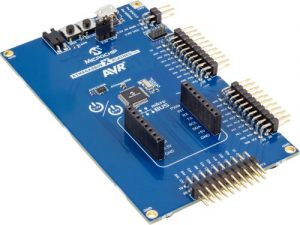
News
Microchip aims at closed-loop control with PICs and ATtinys

Both families have features for functional safety, and operate up to 5V to increase noise immunity and increase compatibility with the majority of analogue output and digital sensors. Both also have peripherals that can co-operate while the processing core sleeps.
PIC18 Q10 includes the firm’s ‘complementary waveform generator’ peripheral that produces non-overlapping drive waveforms for switching PSUs, as well as an integrated ADC with hardware computation that can filter data autonomously. Human-machine interfaces are a potential application.
- 64MHz internal oscillator
- Up to 128kbyte flash program memory
- Up to 1kbyte data EEPROM
- Up to 3.6kbyte data SRAM
- 10-bit ADC2 (ADC with Computation), up to 35 channels
- Four 16-bit timers
- Complementary waveform generator (CWG)
- Two comparators
- Zero crossing detector (ZCD)
- Windowed watch dog timer (WWDT)
- Peripheral pin select (PPS)
- Data signal modulator (DSM)
- Up to 8 configurable logic cells (CLC)
- 5-bit DAC
- EUSART, SPI and I2C
- 28, 40 or 44 pins
Supported comes from Microchip’s Code Configurator that configures peripherals and functions graphically, its downloadable MPLAB X integrated development environment (IDE), and its cloud-based MPLAB Xpress IDE.
For hardware development, there is the Curiosity High Pin Count (HPC) development board (DM164136).
ATtiny1607, in a 3 x 3 mm 20pin QFN, is optimised for space-constrained closed-loop control systems such as hand-held power tools and remote controls. It has a fast ADC for deterministic system response, said the firm, and improved oscillator accuracy – although compared to what, it did not say.
- Internal 20MHz oscillator
- Up to 16 kbyte of flash
- Up to 12-channel, 115ksample/s 10-bit ADC
- Cyclic redundancy check (CRC) scan
- 16-bit real-time clock and periodic interrupt timer
- Configurable custom logic (CCL) peripheral
- 3-channel peripheral event system
- Analogue comparator with scalable reference input
- Configurable, internally generated reference voltage
- USART / SPI / dual-mode TWI
- Up to 22 I/O
Prototyping support comes from the ATmega4809 Xplained Pro (ATmega4809-XPRO, pictured) evaluation kit – a USB-powered kit with touch buttons, LEDs, extension headers, on-board programmer and on-board debugger. This works with Atmel Studio 7 IDE and Atmel Start on-line peripheral configuration tool.